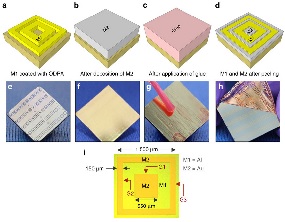River subbasins more depleted than
official figures show
09 April 2024
Published online 16 July 2014

© Beesley, D.J. et al./Nature Communications
Enlarge image
The researchers from Imperial College London and King Abdullah University of Science and Technology, Saudi Arabia, dubbed the new method adhesion lithography.
They etched concentric square rings of aluminium films on a benzocyclobutene-coated glass substrate. Then they smeared a 2-nm thick monolayer of octadecylphosphonic acid on top of the aluminium films, followed by a uniform layer of gold across the full area of the substrate. Solution-coated glue was then applied to the surface of the gold and was allowed to dry.
Once the dried glue was peeled off, it only removed parts of the gold that lay directly above the aluminium, leaving behind alternating, concentric square rings of the two different metals. This led to the formation of gold and aluminium electrodes separated by distances as small as 50 nm.Photodiodes made using the electrodes were able to produce electrical power when illuminated with visible light. “These metal electrodes could potentially be used for fabricating devices such as nanojunction light-emitting diodes, gas and biological sensors and nanochannel field-effect transistors,” says Thomas D. Anthopoulos, a senior author of the study.
doi:10.1038/nmiddleeast.2014.187
Stay connected: